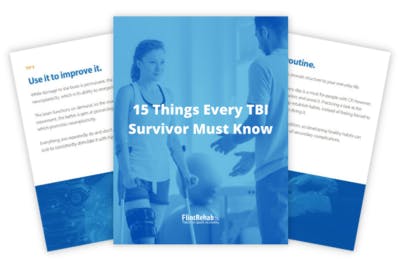No products in the cart.
No products in the cart.
No products in the cart.
No products in the cart.
Home » Neurological Recovery Blog » Traumatic Brain Injury » Brain Damage Recovery Chances: How to Maximize Recovery Outlook
Last updated on June 15, 2021

Every brain injury is unique, which makes it challenging to predict one’s chances of recovery. Many factors are involved in determining one’s recovery outlook after TBI, including the severity of injury, age, prior functional levels, and the onset of secondary complications. Fortunately, even with the most severe cases of brain damage, there is always a chance to recover.
To help you better understand recovery outlook after brain damage, this article will share:
A person’s chances of recovery after TBI heavily depend on the severity of their injury. Generally, the more severe the brain damage is, the lower an individual’s chances of making a functional recovery are. This is not always the case, but it’s the general outlook.
One way to measure the severity of brain damage after TBI is through the Glasgow Coma Scale (GCS). It assesses how conscious a patient is after brain injury based on their eye-opening, motor, and verbal responses. Patients are assigned a score between 3-15. Higher GCS scores are associated with greater consciousness and less severe head injury, which generally suggests better chances of brain damage recovery. However, even after severe brain injuries, recovery is possible.
According to one comprehensive study of 189 patients with a GCS score of 3, 13% achieved a good functional outcome after six months. While this may sound discouraging at first, it’s actually remarkable news considering that the patients started with no consciousness and were only studied for 6 months.
In a separate study that followed patients with severe TBI for four years, 28% achieved a full recovery, and 79% were living independently with only minimal assistance.
Other sources show slightly better odds. According to statistics gathered from the TBI Model System Program regarding individuals with moderate to severe brain damage, at two years post-injury:
This demonstrates that even after the most severe brain injuries, recovery is possible. In the following section, we’ll discuss other crucial factors that play a role in predicting recovery outcomes.
While the severity of brain damage plays a major role in predicting recovery outlook after TBI, it is not the only factor involved.
Other factors doctors may look at to predict brain damage recovery chances include:
Because so many factors can affect brain injury recovery, every individual will have a unique prognosis. Generally, the earlier individuals participate in rehabilitative therapies, the better the outcomes. Up next, we’ll discuss the mechanisms involved in promoting recovery after brain damage.
To improve your chances of recovery after brain injury, it’s essential to understand how the brain recovers. Damaged neurons (nerve cells) in the central nervous system are not capable of regenerating. As a result, physical damage to the brain is permanent.
However, the brain is also incredibly adaptive and can reorganize its circuitry through a mechanism called neuroplasticity. This means that functions affected by brain damage have the potential to be recovered by healthy, undamaged regions of the brain.
The best way to activate neuroplasticity is through repeatedly practicing the functions you want to recover. Consistent practice stimulates the brain and reinforces demand for that function to promote neurological adaptations. The more you practice, the stronger these reorganized connections become.
By utilizing neuroplasticity, many individuals with brain injuries regain abilities they thought were permanently lost. In the following section, we’ll discuss interventions that can help promote brain injury recovery.
Utilizing a combination of various rehabilitation methods can promote better chances of brain damage recovery. Because traumatic brain injuries can affect a wide variety of cognitive and motor functions, a personalized approach to recovery that identifies and targets each individual’s weaknesses is ideal.
Commonly used practices to improve recovery outcomes after brain injury include:
Rehabilitative therapies will provide you with helpful guidance to promote recovery, but it’s ultimately up to you to continuously practice those exercises and activities to optimize your outcomes. The more you practice, the more your brain will adapt, and the better you’ll get.
It is vital to remember that statistics and figures about brain damage recovery chances are not definitive. Even when the odds look grim, it’s always possible to achieve a good recovery.
There are dozens of severe brain injury recovery stories where patients defy all expectations and surprise their doctors with their progress. And in each case, it was because the person ignored negative predictions and persevered with therapy.
We hope this article helped you better understand the various factors involved in determining one’s chances of recovering from brain damage and how to increase your odds.

If you like our content, you’ll love our ebook and newsletters! Get instant access to our TBI recovery tips ebook with 20 pages of helpful advice by signing up below.
You’ll also receive our emails that share survivor stories and more useful TBI recovery tips, which you can opt out of at any time. (We know you’ll love them, too.)
We will never sell your email address, and we never spam. That we promise.


Time with a speech therapist is extremely valuable during recovery, especially if you struggle with communication, critical thinking, or memory after brain injury. Insurance typically covers speech therapy for a fixed amount of time. But once it’s over, recovery is in your hands.
That’s why a team of neuroscientists and clinicians from Boston University created the CT Speech & Cognitive Therapy app. Designed for those recovering from stroke, TBI, or living with neurological conditions, the app contains over 100,000 cognitive exercises that are all available right from your phone or tablet. That’s like having a speech therapist by your side whenever you want!
This app is the perfect fit if you want to improve your speaking, memory, or general mental sharpness. And, it’s affordable at just $29.99/month!
“For the past 6 months, my son has used the app about three times a week. The app is like a virtual therapist, it’s very easy to use, and it gives him immediate feedback.
He now understands things faster, can make decisions with less hesitation, has improved recognition of words, and his confidence is higher. I also find it easy to get in touch with customer service; they pleasantly help out. The whole experience has been great.”
— Miriam
With the CT App, you can get the guidance you need right from your phone or tablet. You can use it on your own or in between sessions with your speech therapist.
Whether you struggle with aphasia, memory loss, or critical thinking, the CT Speech & Cognitive Therapy App can help.
“The CT app has helped me gather my confidence by building on and reinforcing old forgotten skills. It helps to see my percentages increase, and work harder when they decrease. It’s very self-motivating.” -Kathryn
We are confident that this app will help improve your speech and cognitive function after brain injury. Like our recovery tools, the CT App is also covered by our 30-day money-back guarantee.

Do you know these 15 TBI recovery tips?
Get a free copy of our ebook 15 Things Every TBI Survivor Must Know. Click here to get instant access.
Grab a free rehab exercise ebook!
Sign up to receive a free PDF ebook with recovery exercises for stroke, traumatic brain injury, or spinal cord injury below: